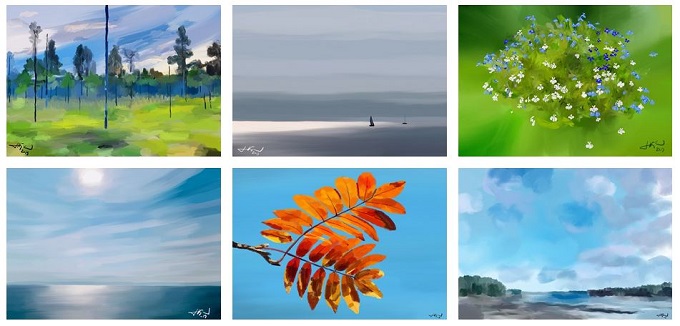This is a summary of my reading and painting over the past two months.
Painting
I mentioned in my previous retrospective that I’ve created a new website where I share my art. Below are some of my recent paintings.

Reading
I’ve read the following books:
Bohm-Biederman Correspondence: Creativity in Art and Science by David Bohm and Charles Biederman. I am deeply impressed by David Bohm. The book strengthens this impression. The correspondence gives insights into Bohm’s thinking and the development of his ideas. Bohm expresses thoughts in his letters which I haven’t found in his other books. Bohm writes, for example, that “love” seems to be “the only feeling that will lead to the action of understanding”.

On the Clock: What Low-Wage Work did to Me and How It Drives America Insane by Emily Guendelsberger. This book is an examination of the day-to-day experience of low-wage work in America in the mid-2010s. The high turnover, and the consequent need to hire new bodies quickly and without scrutiny, is intentional. It’s the cental to the way low-wage work in America operates. It’s a story about human rentals.

Blackfoot Physics: A Journey into the Native American Worldview by F. David Peat. This book is much more interesting than I initially thought it would be. The way we see the world is influenced by our worldviews. The book is an acknowledgement of another way of knowing and seeing. Highly recommended.

Pathways of Chance by F. David Peat. This is an autobiography, which I didn’t find particularly interesting. Peat is a very good writer, though, and I enjoyed his exploration of various scientific and philosophical themes at the end of each chapter.

Does It Matter? by Alan Watts. I read Alan Watts with fascination. Watts tries in this book “to talk about something which is not talk”. He is also astute and wrote already fifty years ago that ” many corporations—and even more so their shareholders—are unbelievably blind”, and that “can no longer simply pass the buck to our children”.

The Book on the Taboo Against Knowing Who You Are by Alan Watts. Watts explores in this book who, or what, we really are. We are in an urgent need—even more so today than when Watts wrote this—of a sense of our own existence which is in accord with physical facts and which overcomes our feeling of alienation with nature.

I’m currently reading the following books:
A Question of Physics: Conversations in Physics and Biology conducted by Paul Buckley and F. David Peat. This book contains interviews with scientist such as Werner Heisenberg, Paul Dirac, Roger Penrose, Ilya Prigogine, Robert Rosen, David Bohm, and others. Buckley and Peat have focused on areas, they feel, hint at the next scientific revolution. It’s an old but very interesting book.

Quantum Implications: Essays in Honor of David Bohm by Basil Hiley and F. David Peat. David Bohm’s interest and influence extended far beyond physics. In this book, Hiley and Peat let the contributors who have been influenced by Bohm speak for themselves. Recommended.

I’ve started reading the following books:
Accounting for Slavery: Masters and Management by Caitlin Rosenthal. Slavery encouraged the development of management practices. Slaveholders built large organizations and conducted productivity analysis. Slavery has systematically been transformed into today’s low-wage work (human rentals). Control is at the heart of management.

Humanity in a Creative Universe by Stuart A. Kauffman. In this book, Kauffman borrows in part from Andreas Weber, who thinks in terms of enlivenment.

I want to read the following books:
A World Beyond Physics. The Emergence and Evolution of Life by Stuart A. Kauffman.

Drawing for Science, Invention and Discovery by Paul Carney.

Integral City: Evolutionary Intelligences for the Human Hive by Marilyn Hamilton

Regenerative Leadership: The DNA of life-affirming 21st century organizations by Giles Hutchins and Laura Storm.

Leave a Reply
You must be logged in to post a comment.